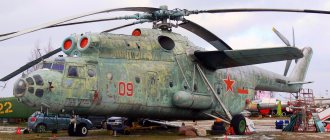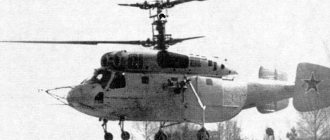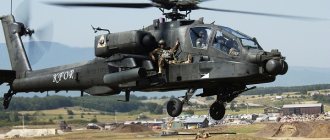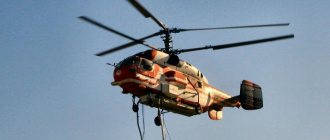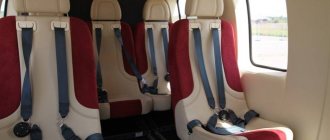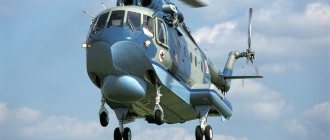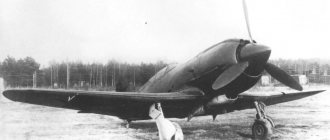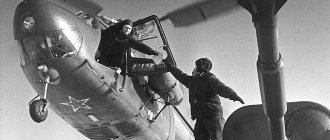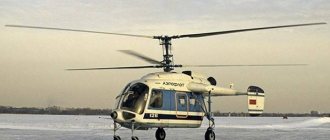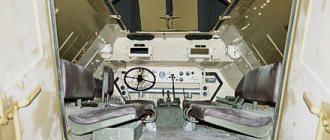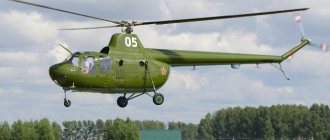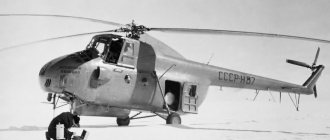Mi-6 is a heavy multi-purpose Soviet helicopter. According to NATO classification, it received the code name “Hook”.
At the end of the 50s, the Luna missile systems entered service in the USSR, for the transportation of which there was a need for a heavy helicopter with a large payload.
The Mi-6 is the first production helicopter of its kind, which is equipped with two turboshaft engines with a free turbine. Its design scheme was taken as a classic in the production of subsequent models of heavy heavy-duty helicopters. At the time of its creation, the Mi-6 helicopter was the most lifting helicopter in the world.
The helicopter was first flown on June 5, 1957. Flight tests of the Mi-6 were carried out in 1959−1963. In 1959 it was produced in Rostov in civilian and military versions.
In 1964−1978 the Mi-6 heavy helicopter was sent for export.
Purpose and modifications of the Mi-6
Mi-6 is a second generation helicopter. In terms of flight performance, the helicopter surpassed many of its domestic and foreign analogues, making an unprecedented leap in the field of helicopter engineering at that time. The layout of the Mi-6 was taken as the basis for the production of many Soviet and foreign helicopters.
The transport-landing Mi-6 was intended to transport troops and military equipment. The Mi-6 transport cabin can accommodate up to 150 people, an armored personnel carrier BTR-152 or 2 self-propelled vehicles ASU-57, various types of weapons: guns, howitzers, etc.
The “flying crane” as a variant of the Mi-6 was widely used when performing crane installation work, transporting drilling rigs and other equipment for mineral exploration.
The ambulance version of the helicopter is designed for the evacuation and transportation of sick and wounded people. The cargo compartment is equipped with space for two paramedics and 40 stretchers.
The passenger version of the Mi-6 has excellent thermal insulation. The helicopter's amenities include a toilet and a wardrobe. The comfortable cabin can accommodate up to 70-80 passengers.
The Mi-6PS modification is designed to search and evacuate spacecraft crews. Its equipment includes: a descent module, winch booms, containers with life rafts and boats. It also has a comfortable lounge for astronauts to relax.
The fire-fighting version of the Mi-6PZh is designed to contain forest fires. The design includes a tank with a central drain neck, which can hold up to 12 tons of water, six hanging tanks with a capacity of 1.5 tons, a foam concentrate, pumps and lowering rods, fire-fighting and rescue equipment.
A series of Mi-6 helicopters for military purposes with installed weapons was also produced.
The Mi-6PRTBV is designed to transport and activate missile power plants, warheads of ballistic or tactical missiles of strategic importance.
This modification is well equipped with camouflage elements.
The Mi-6 anti-intelligence aircraft is designed to counter enemy radio reconnaissance. It has electronic control stations and an automatic control system installed on the outside of the fuselage. Carries out electronic warfare and protects the country's air defense navigation and location systems from being declassified by the enemy.
Mi-6TZ is a fuel tanker for land and aviation equipment.
The Mi-6VKP is intended for a command post from which ground and air forces are controlled. It contains communications center equipment and a lounge for signalmen. Part of the AFU is located outside the helicopter fuselage, and the other is placed on the ground to create a command post.
The Mi-6 repeater is equipped with powerful radar equipment.
Mi-6AYA is a command center for controlling troops without communication with the ground.
Mi-6A is an improved modification that has an increased service life of the main components and new instrumentation.
Characteristics
Below are the characteristics of the Mi-4.
| Modification | Mi-4A |
| Main screw diameter, m | 21 |
| Length, m | 26 |
| Height, m | 4,4 |
| Width, m | 2 |
| Weight, kg | |
| Empty | 5100 |
| normal takeoff | 7150 |
| maximum takeoff | 7550 |
| Engine | ASH-82V |
| power, kWt | 1 x 1250 |
| Max. speed, km/h | 185 |
| Cruising speed, km/h | 140 |
| Range, km | |
| at rated fuel | 410 |
| with maximum fuel reserve | 500 |
| with 1 PTB | 660 |
| Max. rate of climb, m/min | 336 |
| Practical ceiling, m | 5500 |
| Static ceiling, m | 2000 |
| Crew, people | 1-2 |
| Payload: | 12-16 soldiers or 1200 kg of cargo (with overload |
| — 1600 kg) |
https://youtube.com/watch?v=hZkiNeaKx24
https://youtube.com/watch?v=0vKz6we5uDA
Author of the article:
Egorov Dmitry
I am interested in military history, military equipment, weapons and other issues related to the army. I love the written word in all its forms.
Mi-6 design
The helicopter is designed according to a single-rotor design with a wing and a tail rotor. The pilot's cabin is located in the bow. The cargo-passenger cabin is located under the fuel and engine compartments. Thanks to the reinforced floor with mooring points, it became possible to transport heavy loads, including military equipment. The external suspension can be dismantled, this is used for transporting large cargo weighing up to 8 tons.
The auxiliary hydraulic system controls the doors, windshield wipers and ladders. The propeller blades are made from a solid metal tube. To avoid icing, the tail rotor blades are equipped with an alcohol anti-icing system, and the main rotor blades are equipped with an electrothermal one. The Mi-6 is equipped with a non-retractable tricycle landing gear, the front wheels are dual and self-orienting.
Creator
In 1945 Mil M.L. defended his doctoral dissertation “Dynamics of a rotor with articulated blades and its application to the problems of stability and controllability of a gyroplane and a helicopter,” which outlined his experience in researching the design of rotorcraft. Soon he begins developing an experimental helicopter EG-1 (experimental helicopter).
Mil M.L.
In the fall of 1947, a full-size model of the helicopter was presented to the state commission. And on December 12, a decree was issued on the creation of OKB-4, which was headed by M.L. Mil.
The finished model of the machine was named GM-1 (Mil helicopter). On September 20, 1948, a helicopter took off for the first time. During testing, the GM-1 showed satisfactory flight characteristics. However, during test flights, two cars crashed. The accidents were caused by technical defects. It was only thanks to Mil's persistence and enthusiasm that work on the project was not stopped.
Combat use.
The helicopter went into mass production under the designation Mi-1. The first government order was limited to 15 vehicles. Initially, senior circles were quite skeptical about the idea of mass use of helicopters. The situation changed during the Korean War, after information was received about their successful use by the Americans. The Mi-1 and its capabilities were demonstrated to Stalin. After this, large-scale production of the helicopter began. The Mi-1's competitors, the Yak-100 and B-11, did not go into production. From 1954 to 1960 2680 cars were produced.
Ship B-11.
Ship Yak-100.
By its design, the Mi-1 is a helicopter made according to the classic single-rotor design with a tail rotor on the tail boom. The fuselage is semi-monocoque with aluminum skin. The cockpit consists of the pilot's seat and a seat for two passengers located behind him. The landing gear is tricycle non-retractable. The main rotor is three-bladed. The first production machines used blades of a composite structure with steel, wood and fabric elements. On later modifications, all-metal blades made of aluminum alloy were installed. The tail rotor is three-bladed with wooden blades. The power plant consists of an AI-26GRF piston engine (429 kW).
Characteristics of Mi-1
The Mi-1 is a multi-purpose helicopter, which was used both in the Air Force and in civil aviation of the Warsaw Pact countries. In the medical version, the vehicle is equipped with two suspended gondolas for transporting patients. It is possible to install machine guns and rocket weapons.
Maximum take-off weight 2330 kg. Maximum speed 185 km/h. Practical flight range 430 km. The service ceiling is 3500 m. The payload consists of two passengers or 255 kg of cargo.
Full list of characteristics:
Mi-1 video
Mi-1 helicopter. Gallery.
Mi-6 records
During state flight tests of the Mi-6, which took place in 1959−1963, 16 world records were set.
The most significant records:
- lifting a load with a total weight of 5 tons to a height of 5600 m;
- lifting a load weighing over 20 tons to a height of more than 2000 m;
- speed gain of 300 km/h when moving a load of 5 tons per 1000 km;
- speed development of 320 km/h in a closed circle for 500 km;
- achieving a speed of 340 km/h at a distance of 100 km - this record has not been surpassed to this day.
The records made the Mi-6 the most load-bearing and fastest helicopter in the world.
For achieving an absolute speed record of 320 km/h on the Mi-6, the design bureau named after. M.L. Mil received an award - the International Prize named after. Sikorsky I.I. "for outstanding achievements in the development of the helicopter industry."
Characteristics
| Modification | Mi-6 |
| Length, m | 33,18 |
| Height, m | 9,86 |
| Weight, kg | |
| empty | 26500 |
| normal takeoff | 39700 |
| maximum takeoff | 41700 |
| engine's type | 2 GTE D-25V |
| power, kWt | 2 x 4100 |
| Max. speed, km/h | 250 |
| Cruising speed, km/h | 200 |
| Practical range, km | 500 |
| Practical ceiling, m | 4500 |
| Crew, people | 5 |
| Payload: | 6 thousand kg in the cabin (up to 12 thousand kg) or 8000 kg |
| on external sling |
https://youtube.com/watch?v=CvugvNlq75k
https://youtube.com/watch?v=CvugvNlq75k
Author of the article:
Egorov Dmitry
I am interested in military history, military equipment, weapons and other issues related to the army. I love the written word in all its forms.
History of the creation of the Mi-6
The design began at the end of 1952. The model of the helicopter was already ready in December 1953. The first flight was made on May 5, 1957. Serial production of the Mi-6 began at the end of 1959 at the helicopter plant in Rostov, and serial production was also established in Moscow at the Khrunichev plant. In total, 860 Mi-6 helicopters were produced, in civil and military modifications.
Many of the helicopters produced were put into service with the Soviet Air Force, some were exported to India, Vietnam, Egypt, Poland, Syria, Peru, China, Iraq and Ethiopia. Civil Mi-6 helicopters have become an integral part of civil aviation in the USSR and other countries of the world. Removed from serial production in 1980. Operation of the Mi-6 in Russia ceased in 2002.
Multi-role helicopters
Multi-purpose (or general purpose) helicopters are designed to solve a wide variety of tasks, both military and civilian. Depending on the task at hand, a multi-purpose helicopter can spray the ground with both water and fire.
Sikorsky UH-60 Black Hawk
The letters UH in the Black Hawk acronym stand for Utility Helicopter. The Yandex translator translates this phrase simply as “helicopter”. This is, in fact, the exact translation. It is a versatile workhorse for military and civilian applications. For transportation of passengers and cargo. Like the Mi-8, well known in Russia.
This Sikorsky model was developed and put into production as part of the solution to the problem of air transport support for the tactical tasks of the United States Army. The vehicle was supposed to ensure the delivery of 10 armed and equipped soldiers over a distance of several hundred kilometers. At the same time, the flight altitude had to ensure inaccessibility for shelling from the enemy.
Boeing, Sikorsky, Lockheed Bell Helicopter submitted applications for the competition. Sikorsky proposed a traditional single-propeller with two turboshaft engines (TVD) from General Electric. And he won. The device was adopted first by the US Army, and then by the Navy and Air Force. In total, more than 4,000 cars have been produced since 1977, and production continues.
Mi-8
Mi-8, and you don’t need to add anything. Neither the developer, nor the manufacturer, nor any indexes need to be mentioned. And so everything is clear - Mi-8 is Mi-8. This is the most legendary helicopter in the world. A true masterpiece created in 1961 under the leadership of the great Soviet aircraft designer Mikhail Leontyevich Mil, Hero of Socialist Labor, laureate of the Lenin and State Prize of the USSR.
The Mil design bureau in Lyubertsy, near Moscow, created several masterpieces, including the Mi-12, which set a world record for payload that has not yet been broken - 40 tons to an altitude of 2200 meters. But the Mi-8 is the most legendary. The Mi-8, like the Black Hawk, is a true hard worker, a reliable worker in civil and military service.
Over the entire production period, more than 12,000 Mi-8s were produced. Also a world record for twin-engine helicopters. Great helicopter!
Development by KB Mil. The classic Mi-8 model is the most common twin-engine helicopter in the world
It is interesting that during the period of mass privatization in the nineties of the last century, almost 9% of the joint-stock company “Moscow Helicopter Plant named after M. L. Mil” was bought not by anyone, but by Mil’s global strategic competitor as a developer of helicopter equipment, “Sikorsky International Operations Corporation, Inc.” " In a certain sense, this can be interpreted as a return to the homeland of Igor Sikorsky, a native of Russia. Back in the tenth years of the 20th century, Igor Sikorsky designed the first model of his helicopter, and after emigrating to the United States, he became one of the pioneers of American helicopter construction. And now his brainchild owns a tenth of the famous Russian helicopter company.
Bell UH-1 Iroquois
The Iroquois is the same helicopter that was replaced by the UH-60 from Sikorsky. But Sikorsky did not break the great Iroquois record. The Bell UH-1 Iroquois sold an unprecedented 16,000 copies around the world, at least if you take into account all 60 very different single-engine and twin-engine modifications. For its time, the car was excellent, sold all over the world, took part in hostilities many times and proved itself very well.
Many hundreds of copies of the latest modifications of the Iroquois are in service in the armies of dozens of countries in Europe, the Middle East, and America.
Interesting Facts
- During the creation of the design of the heavy Mi-6 helicopter with a total take-off weight of more than 40 tons, even heavy foreign analogues of that time had a maximum take-off weight of up to 15 tons.
- For the first time in the Soviet Union, the Mi-6 provided for the transportation of cargo from the outside of the fuselage.
- The Mi-6 became the first helicopter in the USSR with a gas turbine engine.
- In total, the Mi-6 broke 16 world records.
- In 1961, this model managed to overcome the speed threshold of 300 km/h, which was considered inaccessible for helicopters of that time.
- He took part in the liquidation of the Chernobyl disaster in 1986, where he was often confused with the Mi-26, which also took part in the operation. At the present time, many copies are in ruins at radioactive equipment sites, since their further operation is unsafe. One of these is located near the village of Rassokha (Kiev region).
- On October 12, 2012, at the Moscow Aviation Museum, on Khodynskoye Field, a group of vandals sawed the Mi-6 helicopter into small parts.
Characteristics
Below are the characteristics of the Mi-2:
- rotor diameter - 4.5 m;
- tail rotor diameter - 2.7 m;
- fuselage length - 11.4 m;
- fuselage width - 3.25 m;
- normal take-off weight – 3500 kg;
- Max. take-off weight – 3550 kg;
- engine - 2 × GTD-350;
- power - 2 × 400 l. With.;
- crew – 1 person;
- number of passengers – 10 people;
- Max. speed – 210 km/h;
- range – 580 km;
- ceiling – 4000 m.
Author of the article:
Egorov Dmitry
I am interested in military history, military equipment, weapons and other issues related to the army. I love the written word in all its forms.
Accidents and disasters
01/3/1984 - Mi-6 crash in Novoagansk. The helicopter was transporting cargo and passengers during an oil exploration expedition. During takeoff, it was unable to gain sufficient altitude and crashed into the ground, after which it turned over on its left side and burned out. 38 out of 75 passengers died; the crew, including 5 people, managed to survive. The most likely cause of the disaster is considered to be overloading of cargo. This modification, when fully loaded with cargo, can take on board no more than 60 passengers, but there were 75 of them.
12/11/1990 – plane crash near the city of Korbin (Brest region, Republic of Belarus). While landing in difficult weather conditions, the crew lost control, as a result of which a critical pitch angle was reached. The helicopter fell to the ground and caught fire. The crew commander and his assistant died at the scene of the disaster. The navigator and on-board mechanic, having received huge areas of bodily burns, were transported to the Korbinsk City Hospital, where they also died a couple of days later.
Mi-6 helicopter. Gallery.
Helicopters
TOP 3 most powerful combat helicopters in the world
Combat or attack helicopters are designed to destroy ground targets, including tanks, and air targets, including helicopters. They operate independently or accompany transport or landing helicopters.
Hughes AH-64 Apache
The Latin letters “AH” in the model name mean Attack Helicopter - attack helicopter.
During the life of the AH-64, the Hughes company was sold twice:
- In 1984 it was bought by MacDonald-Douglas;
- In 1997 - Boeing.
The AH-64 is a development of Bell's first attack helicopter, the AH-1 Cobra, which played an important role in Vietnam. But it differs quite seriously from it. The Cobra was designed primarily to fight Vietnamese guerrillas, while the Apache was designed primarily to fight Soviet tanks. The Apache is close to the Cobra in terms of characteristics: size and power, but carries significantly more weapons and electronics.
The eight-ton machine with a propeller with a diameter of 14.6 meters provides for the seating of two pilots in a tandem pattern: the first behind the second. At the same time, to ensure proper visibility, the first pilot sits 40 cm higher than the second. The Apache flies at a speed of 270 km/h over a distance of up to 690 km. To carry out combat missions, it is not only equipped with a 30 mm cannon and suspension mounts for mounting guided or unguided missiles, but it also carries an all-weather weapon system AAWWS (Longbow) with millimeter wave radar.
Today, the AH-64 Apache is the most common attack helicopter model in the world. More than 2,000 pieces were produced.
CAIC WZ-10
CAIC WZ-10 is a Chinese attack helicopter. It’s not a bad model, it’s not for nothing that the legendary Russian Kamov Design Bureau took part in its development. The Kamovites developed a preliminary design commissioned by the People's Republic of China. Then the Chinese acted on their own. And they pierced themselves in typical Chinese style. An unprecedented scandal broke out. The fact is that for many years it supplied engines for Chinese civilian helicopters. The Chinese also, as if nothing had happened, installed a Pratt & Whitney engine on the military WZ-10. They just modernized it a little: they uploaded a new version of the software. On this basis, the Chinese decided that Pratt did not need to seek export permission from the US government. But in court it was established that China hid that the engine was intended for an attack helicopter. CIAC passed off the program as a civilian project. Pratt received a multi-million dollar fine and was forced to stop supplying engines to China. Now the WZ-10 is equipped with a less powerful Chinese-made engine.
Kamov KA-52 "Alligator"
Initially they wanted to use the KA-60 Killer Whale helicopter, but in the heady nineties its development was practically stopped. Kamovites revised the concept and entrusted target designation to the two-seat KA-52, which was supposed to simultaneously perform two roles:
- command vehicle;
- independent attack helicopter.
This is how the KA-52 Alligator appeared. The prototype took off in 1997, regular operation began in 2008.
Unlike Chinese and American attack helicopters, our KA-52 crew members sit side by side. Each of them can both control the flight and use weapons. The outline of the Black Shark with a “two-story” column of rotors, characteristic of Kamov’s helicopters, has been preserved in the Alligator: starting from the 18th frame, the hulls of the models are identical.
Such a two-story column indicates that the helicopter is built according to a “coaxial” design, when two propellers rotate on the same axis, but in different directions. This eliminates the need for a vertical tail rotor. This design distinguishes the Ka-52 from all other models in this review. It has its advantages and disadvantages. Experts note that the coaxial design makes it easier to control the helicopter and improves its maneuverability. But this makes the car more complex and expensive.
Flight performance
Flight performance characteristics (PTC) of attack helicopters
| LTH | Hughes AH-64 | CAIC WZ-10 | KA-52 |
| Crew, people | 2 | 2 | 2 |
| Product length, m | 17,7 | 14,5 | 16,0 |
| Screw diameter, m | 14,6 | 13 | 14,5 |
| Take-off weight, kg | 8 000 | 8 000 | 10 800 |
| Power plant | 2 General Electric turboprop engines, 1560 hp each. | 2 Zhuzhou WZ-9 turboprop engines, 1285 hp each. With. | 2 theater engines of JSC Klimov, 1750 hp each. |
| Speed, km/h | 270 | 270 | 260 |
| Range, km | 690 | 700 | 460 |
| Ceiling, m | 6 100 | 6 400 | 5 500 |
| Gun caliber, mm | 30 | 23 | 30 |
| External suspension, pcs. | 4 | 4 | 6 |
TVD – turboshaft engine.
Performance characteristics of multi-purpose helicopters
| LTH | Sikorsky UH-60 | Mi-8 | Bell UH-1 |
| Crew, people | 3 | 3 | 2 |
| Product length, m | 19,7 | 25,3 | 12,8 |
| Screw diameter, m | 16,3 | 21,3 | 14,6 |
| Take-off weight, kg | 7 907 | 11 500 | 4 310 |
| Passengers, people | 11 | 18 | 14 |
| Power, hp | 2 x 1880 | 2 x 1500 | 1 x 1400 |
| Speed, km/h | 296 | 225 | 204 |
| Range, km | 584 | 520 | 511 |
| Ceiling, m | 5 835 | 5 000 | 5 910 |
| Load capacity, kg | 4 082 | 4 000 | 1 950 |
Performance characteristics of transport helicopters
| LTH | Sikorsky CH-53E | Mi-24 | Boeing CH-47 | Mi-26 |
| Crew, people | 3 | 2 | 2 | 5 |
| Product length, m | 26,9 | 17,5 | 30,1 | 40,0 |
| Screw diameter, m | 22,0 | 17,3 | 18,3 | 32 |
| Take-off weight, kg | 16 644 | 10 500 | 22 680 | 49 500 |
| Power, hp | 2 x 3 925 | 2 x 2 500 | 2 x 4 168 | 2 x 1140 |
| Range, km | 253 | 450 | 1870 | 800 |
| Ceiling, m | 4 220 | 4 950 | 3 090 | 4 600 |
| Passengers, people | 38 | 8 | 44 | 85 |
| Load capacity, kg | 3 629 | 2 400 | 12 284 | 20 000 |
